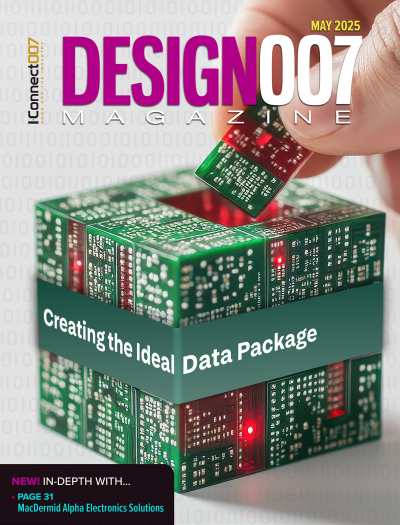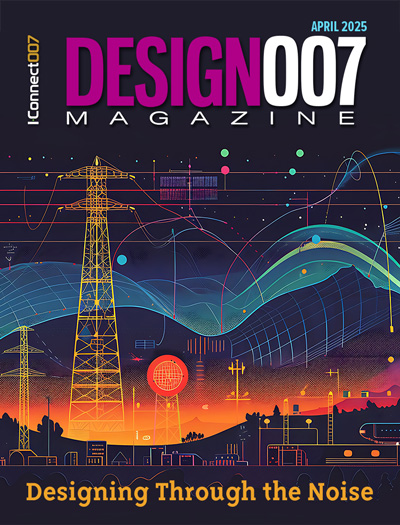-

-
News
News Highlights
- Books
Featured Books
- design007 Magazine
Latest Issues
Current Issue
All About That Route
Most designers favor manual routing, but today's interactive autorouters may be changing designers' minds by allowing users more direct control. In this issue, our expert contributors discuss a variety of manual and autorouting strategies.

Creating the Ideal Data Package
Why is it so difficult to create the ideal data package? Many of these simple errors can be alleviated by paying attention to detail—and knowing what issues to look out for. So, this month, our experts weigh in on the best practices for creating the ideal design data package for your design.

Designing Through the Noise
Our experts discuss the constantly evolving world of RF design, including the many tradeoffs, material considerations, and design tips and techniques that designers and design engineers need to know to succeed in this high-frequency realm.
- Articles
- Columns
- Links
- Media kit
||| MENU - design007 Magazine
Global Robot LLM Market to Exceed $100B by 2028, NVIDIA’s WFM Platform to Drive Growth
January 13, 2025 | TrendForceEstimated reading time: 2 minutes
TrendForce’s latest investigations report that as humanoid robots move toward highly integrated systems and transition from industrial applications to home environments, AI model training will become increasingly critical to meet the growing demands for backend understanding and interaction capabilities. The global LLM market for robotics, including AI training and AIGC solutions, is expected to surpass US$100 billion by 2028, with a CAGR of 48.2% from 2025 to 2028.
At CES 2025, NVIDIA introduced its Cosmos platform, which integrates the World Foundation Model (WFM). This platform is expected to become a key driver of market growth.
The Cosmos platform—closely tied to robot development—leverages real-world data and AI-generated data to build digital twin environments for training. This approach offers advantages such as cost reduction, simplified processes, customized training, and more realistic interaction simulations.
NVIDIA aims to accelerate the development of general-purpose robotics technologies with Cosmos while recognizing the evolution of AI from generative AI to agentic AI and, eventually, physical AI. This progression is crucial for autonomous vehicles and robots to advance training processes and achieve broader commercial deployment.
One of the key challenges in robot training is the sim-to-real gap—the discrepancy between virtual training environments and real-world conditions. Deep learning and neural networks primarily rely on simulated data, which can lead to inefficiencies in real-world performance due to a lack of alignment with physical properties, sensor data, and actuator dynamics.
NVIDIA introduced the NaVILA model in December 2024 to bridge this gap, enabling robots to understand natural language commands without pre-training or mapping and navigate complex terrains using visual systems and LiDAR technology.
Currently, AI training and AIGC solutions account for 10% of humanoid robot costs, representing the largest cost share on the software side. Other cost contributors include operating systems (4%) and autonomous navigation (3%).
Several key players in NVIDIA's ecosystem are driving advancements in robotic simulation technologies. Companies such as Siemens, Vention, and Hexagon specialize in robot simulation, while Rockwell Automation, PTC, and Cadence focus on computer-aided engineering (CAE) and reality capture. Additionally, MetAI, a Taiwanese startup, contributes innovative solutions to the ecosystem.
TrendForce emphasizes that NVIDIA’s Cosmos platform is poised to address the training gap challenges, highlighting the importance of AI large model simulations. This development marks a critical step toward commercializing humanoid robots and integrating them into everyday life.
Leading humanoid robot developers, including Figure AI and 1X, are expected to be among the early adopters of the Cosmos platform, setting the stage for a new era of AI-driven robotic innovation.
Suggested Items
The Knowledge Base: Building the Workforce of Tomorrow With EMAC
06/24/2025 | Mike Konrad -- Column: The Knowledge BaseAs the electronics manufacturing industry races to meet rising global demand and technological complexity, the need for a highly skilled, future-ready workforce has never been greater. At the forefront of addressing this challenge is The Electronics Manufacturing & Assembly Collaborative (EMAC)—a national initiative dedicated to strengthening the talent pipeline through strategic collaboration with SMTA, education, and government stakeholders.
It’s Only Common Sense: Why Sales Teams Fail (and How to Fix Them)
06/22/2025 | Dan Beaulieu -- Column: It's Only Common SenseIn sales, success is never a given. Despite best intentions, the most well-resourced sales teams can stumble. Understanding why is the first step toward creating a high-performing sales force. Here are the main reasons sales teams fail—and actionable strategies to fix them.
STI Celebrates Travis Wease’s 10 Years of Dedicated Service
06/17/2025 | STI Electronics, Inc.STI Electronics, Inc., a full-service organization providing training services, training materials, analytical/failure analysis, prototyping, and contract electronic manufacturing, proudly celebrated the 10-year work anniversary of Travis Wease, Master Instructor and valued team member.
Bridging the Knowledge Gap in Test: A Conversation with Bert Horner
06/11/2025 | Barry Matties, I-Connect007Bert Horner is a seasoned industry veteran and co-creator of The Test Connection, Inc. (TTCI), a test and inspection company spanning over 45 years. In this candid conversation, Bert reflects on the challenges our industry faces with the retirement of career professionals and the subsequent loss of critical tribal knowledge. As he unveils The Training Connection’s innovative training initiatives, Bert emphasizes the importance of evolving educational programs that align with industry needs, particularly in design for test (DFT), and sheds light on strategies being implemented to foster the next generation of engineers.
IPC Launches New Wire Harness Design Course Led by Defense Industry Expert
06/03/2025 | I-Connect007 Editorial TeamIPC is expanding its educational offerings with a new online course designed to provide foundational knowledge in wire harness and cable design. The course, Introduction to Wire Harness Design I, is led by a seasoned mechanical engineer and subject matter expert in military cable systems working at FNSS Defense Systems in Turkey.


